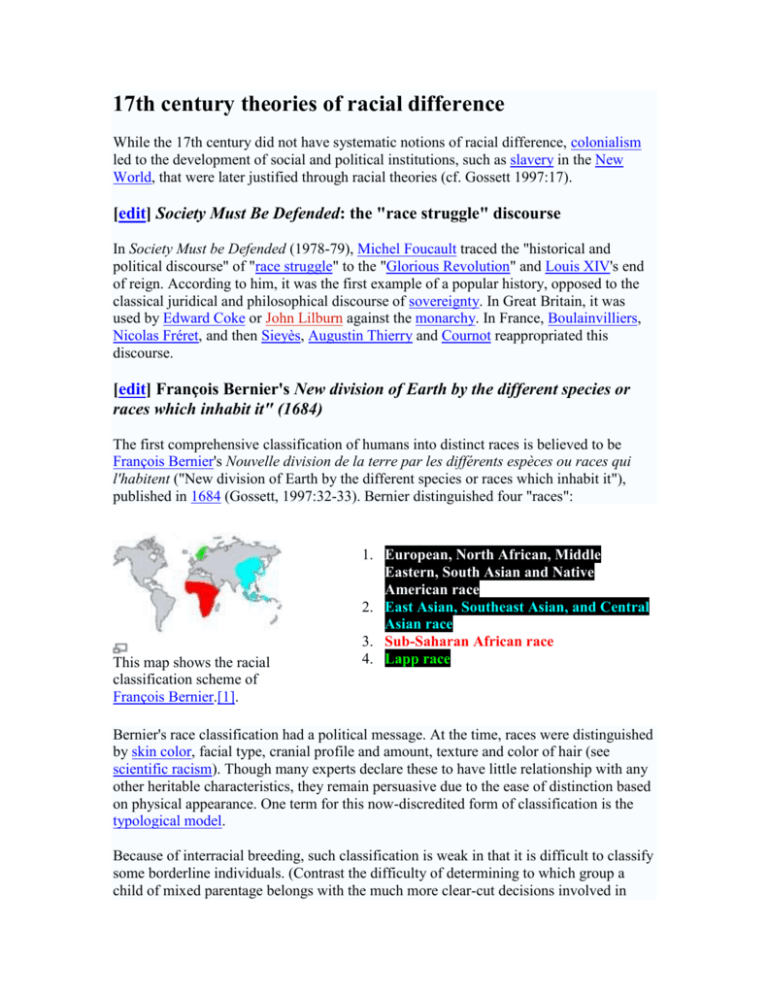17th century theories of racial difference
advertisement

17th century theories of racial difference While the 17th century did not have systematic notions of racial difference, colonialism led to the development of social and political institutions, such as slavery in the New World, that were later justified through racial theories (cf. Gossett 1997:17). [edit] Society Must Be Defended: the "race struggle" discourse In Society Must be Defended (1978-79), Michel Foucault traced the "historical and political discourse" of "race struggle" to the "Glorious Revolution" and Louis XIV's end of reign. According to him, it was the first example of a popular history, opposed to the classical juridical and philosophical discourse of sovereignty. In Great Britain, it was used by Edward Coke or John Lilburn against the monarchy. In France, Boulainvilliers, Nicolas Fréret, and then Sieyès, Augustin Thierry and Cournot reappropriated this discourse. [edit] François Bernier's New division of Earth by the different species or races which inhabit it" (1684) The first comprehensive classification of humans into distinct races is believed to be François Bernier's Nouvelle division de la terre par les différents espèces ou races qui l'habitent ("New division of Earth by the different species or races which inhabit it"), published in 1684 (Gossett, 1997:32-33). Bernier distinguished four "races": This map shows the racial classification scheme of François Bernier.[1]. 1. European, North African, Middle Eastern, South Asian and Native American race 2. East Asian, Southeast Asian, and Central Asian race 3. Sub-Saharan African race 4. Lapp race Bernier's race classification had a political message. At the time, races were distinguished by skin color, facial type, cranial profile and amount, texture and color of hair (see scientific racism). Though many experts declare these to have little relationship with any other heritable characteristics, they remain persuasive due to the ease of distinction based on physical appearance. One term for this now-discredited form of classification is the typological model. Because of interracial breeding, such classification is weak in that it is difficult to classify some borderline individuals. (Contrast the difficulty of determining to which group a child of mixed parentage belongs with the much more clear-cut decisions involved in determining membership in species). In other words, racial purity has no clear biological meaning. It is clear, though, that for an extended period of time after Homo sapiens' first migrations from Africa (probably around 80,000 BCE) and before the rise of wheeled and seagoing transportation (around 3,000 BCE), geographically isolated groups of people underwent some degree of divergent evolution. Whether that degree was high enough to merit strict taxa beneath the species level is a question discussed by human biologists since the 1800s. It is a complicated issue full of semantic and emotional pitfalls, with much at stake on the consensus for all who look upon science as the bedrock authority for decisions in their daily lives. [edit] 18th century anthropologists [edit] Carolus Linnaeus This map shows the racial classification scheme of Carolus Linnaeus. 1. 2. 3. 4. 5. 6. 7. Africanus negreus Americanus rubenscens Asiaticus fucus Europeus albescens Feral Monstrosous Anthropomorpha No Classification [edit] 19th century anthropologists Among the 19th-century naturalists who defined the field were Georges Cuvier, James Cowles Pritchard, Louis Agassiz, Charles Pickering (Races of Man and Their Geographical Distribution, 1848), and Johann Friedrich Blumenbach. Cuvier enumerated three races, Pritchard seven, Agassiz twelve, and Pickering eleven. Blumenbach's classification was widely adopted: 1. 2. 3. 4. 5. this map shows the racial classification scheme of Johann Friedrich Blumenbach. Caucasian race Mongolian race Ethiopian race American race Malay race [edit] Louis Agassiz's Racial Definitions This map shows the racial classification scheme of the naturalist Louis Agassiz. 1. Arctic race 2. Western American Temperate race 3. Eastern American Temperate race 4. American Tropical race 5. South American Temperate race 6. Cape of Good Hope race 7. Tropical Asiatic race 8. Temperate Asiatic race 9. European Temperate race 10. African zoological race 11. New Holland race 12. Pacific race [edit] Thomas Huxley's Racial Definitions This map shows the racial classification scheme of the anthropologist Thomas Huxley from his book On the Geographical Distribution of the Chief Modifications of Mankind (1870). Esquimaux race American race Amphinesian race Negrito race Australian race Mongolian race Negro race Bushmen race Mincopies race Xanthochroi race Melanochroi race 1. 2. 3. 4. White race Black race Yellow race Degenerative race [edit] Joseph Arthur Comte de Gobineau This map shows the racial classification scheme of the anthropologist Joseph Arthur Comte de Gobineau. [edit] 20th Century Anthropologists [edit] Stanley M. Garn's Racial Definitions 1. Amerindian race 2. Asiatic race 3. Australian race 4. Melanesian race 5. Micronesian race 6. Polynesian race 7. Indian race 8. African race 9. European race This map shows the racial classification scheme of the anthropologist Stanley Marion Garn in his book Human Races (1961), although he considered thirty-four local subraces to exist within the nine major races. [edit] William Henry Boyd's Racial Definitions 1. Early European race 2. European race 3. African race 4. Asiatic race 5. American Indian race 6. Australoid race This map shows the racial classification scheme of the anthropologist William Henry Boyd in his book Genetics and the Races of Man (1956). [edit] Egon Freiherr von Eickstedt's Racial Definitions for Europe 1. 2. 3. 4. Racial classification of Europeans by the 20th century anthropologist Alpine race Osteuropid race Nordic race Mediterranean race Egon Freiherr von Eickstedt from his book Ethnology and the Race History of Mankind. [edit] Jan Czekanowski's Racial Definitions for Europe Mixed Types Pure Races This map shows the racial classification scheme of the anthropologist Jan Czekanowski in his book AAnz, vol. 5 (1928). 1. α =Nordic race 2. ε =IberoInsular race 3. λ =Lapponoi d race 4. χ =Armenoid race 1. ι =Northwestern mixed type 2. γ =Subnordic mixed type 3. ω =Alpine mixed type 4. ρ =Littoral mixed type 5. β =Pile Dwelling mixed type 6. δ =Dinaric mixed type Researchers in the decades following Blumenbach classified the Malay and American races as branches of the Mongolian, leaving only the Caucasian, Mongolian, and Ethiopian races. Further explication in the early and mid twentieth century, arrived at three primary races: Negroid Caucasoid Mongoloid or Sinoid with a small number of less widespread races. [edit] Carleton Coon's Racial Definitions The most widely referenced 20th century racial classification, by American anthropologist Carleton S. Coon, divided humanity into five races: Caucasoid race Congoid race Capoid race Mongoloid race Australoid race This map shows the racial classification scheme of Carleton S. Coon [2]. Coon assigned even some populations on sub-Saharan Africa to a broadly defined Caucasoid race, leading to charges that peoples with recorded ancient civilizations were being defined out of the black race, in order to depict the remaining "Congoid" race as lacking in culture. Coon and his work were widely accused, even at the time, of obsolete thinking or outright racism, but some of his terminology continues in use to a lesser degree even today, even though the "-oid" terms now have negative connotations [3]. In addition to references in legitimate scientific discussion, Coon's macro-racial classification, as well as his detailed list of European "subraces", is popular with racist groups who agree with the existence of distinct racial types, and is widely reproduced on "white nationalist" websites. See The Races of Europe, for further information. [edit] J.D. Clark map of African distribution Africans were of many different types, shapes and colors, and extended from South Africa to the tips of northern Africa. Development was from a single species according to the multiregional hypothesis of evolution combining Homo erectus, Neanderthals, Homo sapiens and other humans. These changed over time from a generalized African or Africoid type, due to interbreeding, replacement, genetic drift and other vehicles of evolution, into the dominant Homo Sapiens of today. [edit] Criticism of the biological significance of the notion of "race"






